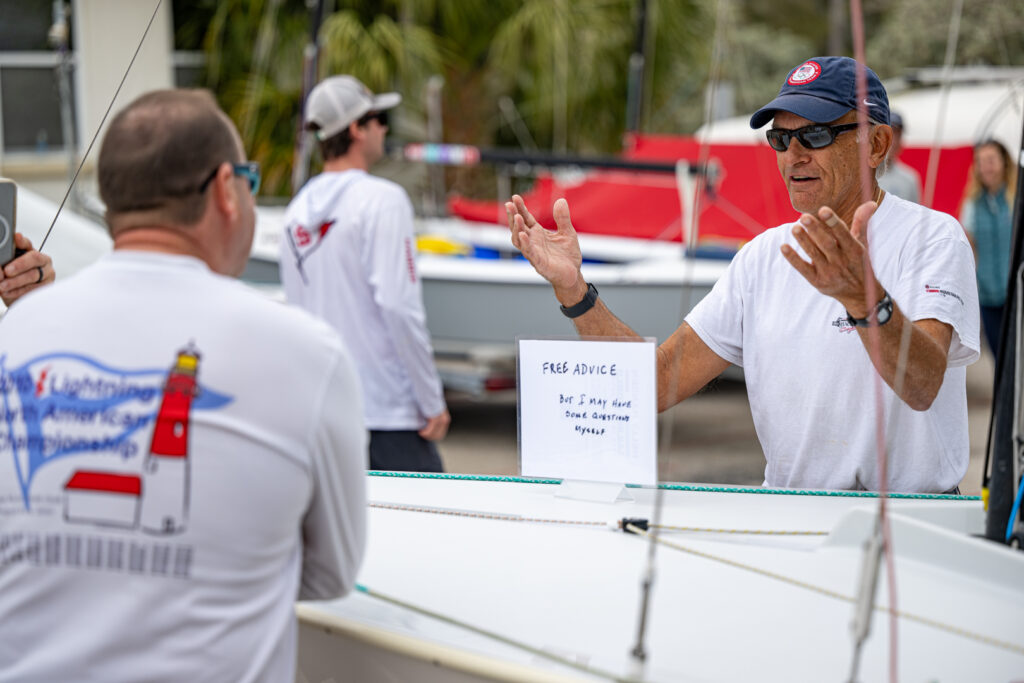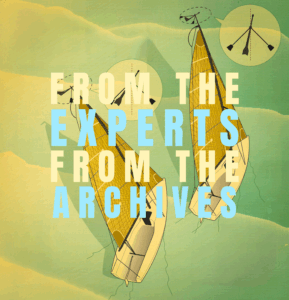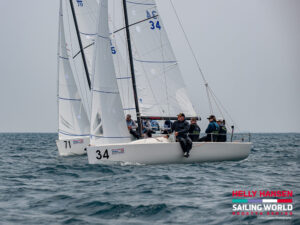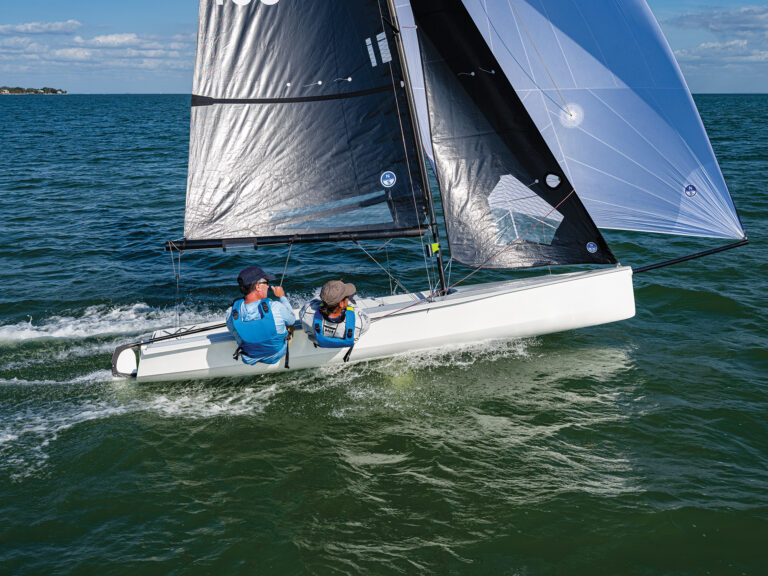
National Sailing Hall of Fame inductee, Snipe and Star world champion, and PanAm games medalist Augie Diaz has been getting up to speed in the Lightning, another classic one-design that continues to produce generations of smart, fast and technical sailors. On the first day of the 2024 Helly Hansen Sailing World Regatta Series in St. Petersburg we staged an “Ask Augie” session with Lightning sailors as we waited out a postponement. We invited a few to ask away, but dozens lined up at the chance to quiz a legend. Here’s what we gleaned in less than 20 minutes of wonderful advice from the legend himself.
What’s your favorite thing in a crew?
That the crew gives me as much information as possible, and never gets insulted when I don’t do what they’re telling me to do.
What’s your routine?
Generally, I’m late, So I try to go early. But I just try to get my mindset ready, look at the weather, get a weather update, and then try to get to the park in time to make sure my tune is good. And just to not be rushed. Because generally, if I’m late, then I’m rushed. Then I’m not relaxed.
What is the breakfast of champions?
I like a good breakfast because you have to have something in your body for the day. Generally what I like to have is just some eggs, and maybe some protein. This morning, I went off track a little bit because my buddy Enrique Quintero made some bacon. Bacon is always great, but why is bacon so great and then it’s bad for you? So, I like to stay away from bacon. But generally, I get toast, eggs and protein.
Favorite boat: Stars or Snipes?
I get this asked all the time: What’s my favorite boat? And it’s a very simple answer: It’s the last one I sailed.
You seem to sail with light women? How do you make the boat go so fast and the big breeze?
Generally, I sail with girls that are used to hiking; like those that are Snipe sailors. And those girls are pretty used to hiking. And then I have a steady flow of discussion that goes like this: Flat, flat, flat. I just keep saying that, and so it works.
What is the best and most fair weather to sail?
I like the breeze. I liked it all my life. And even at my age, now that it’s getting harder, I still like the breeze a lot. I just think that when you have a better feel of the boat and breeze, the boat talks to you a little bit more. So, I really enjoy that part of it. So I would say breeze. Breeze on.
If you get caught in a tight lane, and you don’t want to bail out of it and you really need to hold your position, any tricks on keeping your position?
That happens to me a lot because I’m not a great starter. So I’m usually in a position where I’m kind of in a tight lane, and what I try to do is make sure that before the race, I have what I call a high mode. I will announce it: “high mode,” and a high mode generally means we’re pulling in the sheets a little bit tighter. And then we’re being careful not to over trim the backstay because when you over trim the backstay you lose a little leech. For me, height is about how well that leech is working. So, I’ll say: “high mode, high mode, high mode, I need height,” and then we pretty much all do what we need to do. Steering has a lot to do with it. If you get caught too high, that’s bad, because then you start going sideways. So, you have to really balance it where you trim in, you keep your height, and you just live.
When you’re racing and you feel slow, what’s the first thing you do to change?
What I try to do is ease. Generally, I’m a pincher, so when I’m going slow, the first thing I do is I try to ease the sails a little bit, and try to put the bow down and that always gives you a good feel for what you know for what you have to do next. So, I think to be disciplined about feeling slow, then you ease the sails out a little bit, and put the bow down a little bit and get flow. Because the biggest problem for pinchers is that you lose flow on the blades. And not just not only the blades in the water, but also on your foils above, the sails. It’s all about flow. It’s like flying.
What about going downwind?
I generally end up heading up because when I’m going slow I feel like I’m too low. And that’s generally what I try to do is try to keep a feel for what the angle should be, which is really hard in the Lightning. The legacy guys like Debbie Probst, Jody Starck, Ched Proctor, they know this stuff instinctively. So, for me, I’ve had to work on it, and it’s tough.
What is the first thing you think about when you have a poor start? If you have a post start other than a general recall. Other than hoping for a general recall?
I have had a lot of practice at this, so for me it begins before the actual start. I try to get to a place where, if I mess up the start, I’m going to have a good exit. Generally, that means you’re a little bit further up the line closer to a committee boat. But I don’t panic. I try not to panic, I do panic, actually. But I try not to panic. Because my tendency is to try to clear out from a bad start and I try to clear too fast. And sometimes I use the verbiage with my team: “We need to live here until it clears out.” And if you wait just 30, 45 seconds, and you’re in bad air, you’re hurting, you know, but you allow things to clear out a little bit behind you, then it gets a lot easier. It’s harder in the Lightning than in other classes because in a Lightning we sail tighter. There’s a lot of good people. And you end up having less of an opportunity to clear yourself.
We’re starting a U32 initiative to get more post collegiate sailors into the Lightning class; what’s your advice for encouraging more people to join the Lightning class?
I think you’ve got to invite them to get on the boat and go sailing. I think that will get a lot of people right off the bat. I think this issue of being able to go fast in a Lightning is very critical. I think you have to leverage the class stalwarts, like Ched, David Starck and Jodie and Tommy Stark, and really make it so that when people come into the class, they get accepted like I was. It’s hard because it takes time. It takes a commitment, but I think the class can do it. It’s not a problem, but I think it’s a step in the right direction. We’re doing that also very effectively in the Snipes, and it’s all about having fun. Our racing here in the Lightning is very similar to collegiate racing; it’s super tactical. And this is something that all these college kids come out of college from super tactical situations. When they start sailing J/70s or something like that, those are not tactical boats because you can’t tack a lot, and downwind you have to go to the corners. The secret to our class is the way we have a lot of fun and how tactical it is. In the end it’s fun. It’s like playing chess and lifting weights at the same time.
What advice do you have for a team who is just starting out together just starting to sail together and maybe have not sailed together before?
Communication is key, and having a discussion before you get on the boat as to who’s doing what. I use a lot of mental visualization exercises. And I do that on the fly. I did that when I was in high school and I thought it was daydreaming. But it wasn’t daydreaming. I was actually practicing in my mind. But really, communication before you jump into the boat, I think is super important. I’ve gone as far as setting up in a living room, where you have two benches and simulate a cockpit and you walk through your maneuvers, because the Lightning is pretty tricky in terms of your maneuvers. So, that’s what I would recommend: doing a lot of communication and a lot of mental visualization prior to getting on the boat. And then of course sailing as much as you can together. That’s always key.









